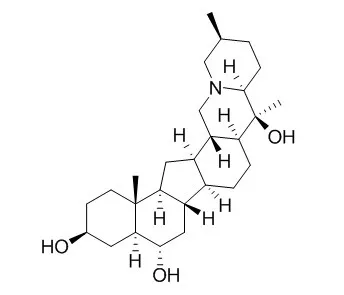| Description: |
Peimine has good anti-inflammatory effects in vivo, it inhibits the production of inflammatory cytokines induced by LPS through blocking MAPKs and NF-κB signaling pathways. It also has antitussive and sedative actions, the action being suspected to be central in nature. |
| Targets: |
IL Receptor | TNF-α | NF-kB | p65 | p38MAPK | ERK | JNK | IkB | IKK |
| In vitro: |
| Immunopharmacol Immunotoxicol. 2013 Oct;35(5):567-72. | | Peimine impairs pro-inflammatory cytokine secretion through the inhibition of the activation of NF-κB and MAPK in LPS-induced RAW264.7 macrophages.[Pubmed: 23944357] | In the previous study, we found that Peimine has good anti-inflammatory effects in vivo. However, the anti-inflammatory mechanism of Peimine remains unclear. We, therefore, assessed the effects of Peimine on inflammatory cytokines in lipopolysaccharide (LPS)-stimulated RAW 264.7 macrophages.
METHODS AND RESULTS:
We found that Peimine (0-25 mg/L) significantly inhibited tumor necrosis factor (TNF)-α, interleukin (IL)-6, IL-1β, and increased IL-10 production. Furthermore, Peimine significantly inhibited the phosphorylation of p38, ERK and c-jun N-terminal kinase (JNK) as well as decreased p65 and IκB.
CONCLUSIONS:
The present results indicate that Peimine inhibits the production of inflammatory cytokines induced by LPS through blocking MAPKs and NF-κB signaling pathways. |
|
| In vivo: |
| Pharmazie. 2011 Sep;66(9):684-9. | | Comparative pharmacokinetic studies of peimine and peiminine in rat plasma by LC-MS-MS after oral administration of Fritillaria thunbergii Miq. and Fritillaria thunbergii Miq. - Glycyrrhiza uralensis Fisch. couple extract.[Pubmed: 22026124] |
METHODS AND RESULTS:
A sensitive LC-MS-MS method has been successfully applied to pharmacokinetic study of Peimine and peiminine in rat plasma after oral administration of Fritillaria thunbergii Miq. exact and Fritillaria thunbergii Miq. - Glycyrrhiza uralensis Fisch. couple extract. The results indicated that plasma profiles of Peimine and peiminine confirmed to two-compartment open model with weighting function of 1/C2 for data fitting and parameter estimation and the utilization with Glycyrrhiza uralensis Fisch. could decrease C(max) and prolong MRT(0-infinity) and t1/2 of Peimine remarkly with the bioavailability of Peimine remained practically unchanged. Meanwhile, the concentration of Peimine in rat plasma was more stable.
CONCLUSIONS:
Nevertheless, there were no significant differences among all calculated parameters of peiminine. | | Acta Pharmaceutica Sinica, 1985, 20(4):306-8. | | Studies on the antitussive and sedative activities of peimine and peiminine.[Reference: WebLink] | The antitussive and sedative activities of Peimine and peiminine, two alkaloids isolated from Fritillaria verticillata Willd var thunbergii Bak, were investigated in laboratory.
METHODS AND RESULTS:
The EDT_(50) (the time needed to make 50% mice cough) was prolonged to 130% of the control when Peimine or peiminine 4 mg/kg was administered orally to mice induced to cough by atomized ammonium hydroxide. A 45% inhibition rate of cough amplitude was observed in anesthetized guinea pig induced to cough by stimulation of the mucosa at the tracheal bifurcation with a bristle after a sc injection of Peimine or peiminine 4 mg/kg. Peak action appeared 30~60 minutes after the injection. In cats, induced to cough by electrical stimulation at the central stump of the superior laryngeal nerve, both the incidence and amplitude of cough reflex were inhibited by sc injection of 4 mg/kg of Peimine or peiminine. The action lasted for an hour or so.The spontaneous activities of mice were significantly decreased by Peimine or peiminine after sc injection of a dose of 2 mg/kg. Furthermore, the CNS stimulating action of caffeine was antagonized and the sedative action of chlorpromazine was potentiated by Peimine and peiminine in mice at the same dose level. It appears that both Peimine and peiminine have antitussive and sedative actions, the former action being suspected to be central in nature.
CONCLUSIONS:
However, no difference of pharmacological action, either qualitatively or quantitatively, between peiminine and peiminine has thus far been demonstrated. |
|






 Cell. 2018 Jan 11;172(1-2):249-261.e12. doi: 10.1016/j.cell.2017.12.019.IF=36.216(2019)
Cell. 2018 Jan 11;172(1-2):249-261.e12. doi: 10.1016/j.cell.2017.12.019.IF=36.216(2019) Cell Metab. 2020 Mar 3;31(3):534-548.e5. doi: 10.1016/j.cmet.2020.01.002.IF=22.415(2019)
Cell Metab. 2020 Mar 3;31(3):534-548.e5. doi: 10.1016/j.cmet.2020.01.002.IF=22.415(2019) Mol Cell. 2017 Nov 16;68(4):673-685.e6. doi: 10.1016/j.molcel.2017.10.022.IF=14.548(2019)
Mol Cell. 2017 Nov 16;68(4):673-685.e6. doi: 10.1016/j.molcel.2017.10.022.IF=14.548(2019)